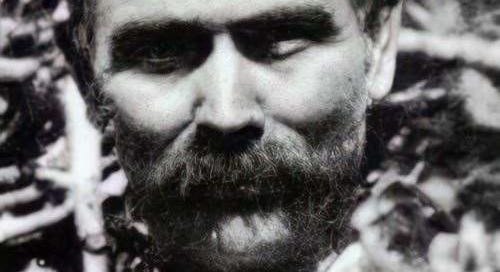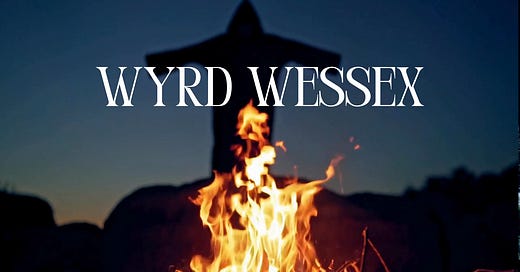
It's Valentine's Day, and while roses and chocolates might be the typical agenda, we're diving into something a little darker: the unsolved murder of Charles Walton. This gruesome tale from a quiet English village in 1945 is a chilling mix of true crime, witchcraft accusations, and eerie folklore, a case that continues to fascinate and disturb.
A Grim Discovery on Valentine's Day
In the biting winter of 1945, as World War II neared its end, the small village of Lower Quinton became the scene of a perplexing and disturbing murder. 74-year-old Charles Walton, an agricultural worker, was found dead in a field near Meon Hill, his body bearing the marks of a brutal attack. His throat had been savagely slashed open, he'd been beaten over the head with his own thick walking stick (found 3.2 meters from his body, with blood and hair adhering to it), and his own pitchfork and slash hook (a pruning tool with a sharpened straight edge and a concave cutting edge) had been used to further mutilate his body. The tines of his pitchfork were driven into either side of his neck, pinning him to the ground, the handle wedged beneath a cross member of the hedge. A large cross was carved into his chest. His shirt had been opened, and his trousers were unfastened at the top.
Walton, a widower, lived with his adopted niece, Edith Isabel Walton (often incorrectly referred to as his wife). He was known as a loner, preferring the company of horses to people, having earned a reputation as a trainer of horses in his youth. He was described as someone who didn't socialize much with his neighbors, though he wasn't actively disliked. On that fateful Valentine's Day, he'd set out early to do hedge-trimming work at The Firs farm, located on the slopes of the ominous Meon Hill, a place steeped in local legends. He'd left without his purse, carrying only his pitchfork and slash hook.
Edith, expecting him home by 4 pm, grew worried when he didn't return. She sought help from a neighbor, Harry Beasley, and together they went to The Firs to alert Alfred Potter, the farmer. Potter claimed to have last seen Charles around noon, with only a small amount of hedging left to do. The three of them set out in the gathering darkness and discovered Walton's body. Edith’s screams alerted a nearby walker, Harry Peachey, who went to alert the police.
A Brutal Crime and a Frustrating Investigation
The police investigation, which included Stratford CID, forensic scientist Professor Webster, and later Scotland Yard, was extensive but ultimately fruitless. Over 500 residents of Lower Quinton, some as young as eleven, and other individuals in the area on February 14th were interviewed. A detailed search, aided by the Royal Engineers and their mine detectors, was undertaken, but no concrete evidence was found. Walton's watch was missing, adding another layer to the mystery.
Suspicion fell on Alfred Potter, the farmer Walton worked for. Potter's changing stories and uneasy demeanor raised red flags. He seemed agitated and evasive, and his story about the time he saw Charles in the field kept changing. Rumors persisted that Potter owed Walton money. However, despite the scrutiny, no evidence linked him definitively to the crime. Fabian found no evidence of violence in Potter's past or any quarrels with Walton, describing him as morose and sullen, yet also cunning and strong. And then there were the trousers. A few spots were found that might have been blood, but they'd been scrubbed too thoroughly to be analysed.
Professor Webster's post-mortem revealed the brutal nature of the attack. Walton's trachea had been cut, and he had bruising to his chest and several broken ribs. His body also bore signs of a struggle, with defensive wounds including a cut on his left hand and bruising on his right hand and forearm. Webster concluded that Walton's wounds had been caused by two weapons—a stabbing weapon and a cutting weapon, presumably the pitchfork and the slash hook. Webster's official report makes no specific mention of the cross—a detail that would later loom large in the popular folklore of the case.
Whispers of Witchcraft and Ancient Legends
The case took a strange turn with the emergence of local folklore and accusations of witchcraft. Walton was rumored to be a witch, capable of casting the evil eye and controlling the local wildlife. Some villagers believed he'd cursed their crops and livestock. The timing of the murder, coinciding with a failed harvest in 1944 and the death of Potter's heifer on 13 February—the day before the murder—fueled these suspicions.
The cross carved into Walton's chest, though not explicitly mentioned in the official autopsy report, became a focal point for those believing the murder was a ritualistic killing, a pagan sacrifice to appease ancient forces, a practice that was claimed to be rooted in ancient pagan beliefs.
Meon Hill, near where Walton's body was found, is an ancient burial mound steeped in its own legends. Locals spoke of ghostly figures and strange lights, and a general sense of unease that hangs over the hill, adding to the eerie atmosphere surrounding the case. The proximity of the murder to this site fueled speculation about a connection to ancient rituals.
Adding to the sense of ancient mystery surrounding the Walton case are the nearby Rollright Stones. This collection of prehistoric monuments, including a stone circle and a solitary standing stone, has stood for millennia, steeped in folklore and legend. Some have speculated whether these ancient stones hold any connection to Walton's murder, perhaps linked to ancient pagan rituals or some forgotten power that lingers in the landscape.
However, as Gerald B. Gardner points out in The Meaning of Witchcraft, "...the Whispering Knights... are about twelve miles away... from Lower Quinton, making a direct connection unlikely, and as no one knows for certain just what the Druid's ceremonies were, it is impossible to say that his death was a reproduction of one." While Gardner's words caution against drawing direct parallels, the mere presence of these enigmatic stones adds another layer to the unsettling atmosphere of the region, hinting at a past where the boundaries between the natural and supernatural may have been more permeable.
Echoes of the Past: The Ann Tennant Case
The Walton case shares striking similarities with the earlier murder of Ann Tennant in 1875. Tennant, also accused of witchcraft, was attacked with a pitchfork and killed by James Heywood, who was found not guilty on the grounds of insanity and spent the rest of his life in Broadmoor Criminal Lunatic Asylum. The parallels between the two cases, separated by decades, are chilling. On 13 February 1954, the eve of the ninth anniversary of Walton's murder, the Daily Mirror revisited the killing of Ann Tennant, drawing parallels between the two cases and alleging a further, undisclosed link. The only real similarities between the murders are that a pitchfork was used and both victims had been accused of witchcraft.
Another Local Mystery: Who Put Bella in the Wych Elm?
Just a short distance away, another chilling mystery unfolded around the same time as the Walton murder – the case of "Bella in the Wych Elm." In 1943, some children stumbled upon a body hidden inside a hollow wych elm tree in Hagley Wood. Like the Walton case, this one is shrouded in unanswered questions. Who was Bella? How did she die? And who put her in the wych elm? The eerie parallels between the two cases – the rural setting, the unsolved nature, the lingering sense of unease – add another layer to the unsettling atmosphere of the time. While seemingly unconnected, these two mysteries, occurring so close together, contribute to a broader narrative of the strange and the unexplained in the heart of England.
The Spectral Black Dog and a Town of Secrets
Adding to the mystery is the legend of the spectral black dog, a common figure in British folklore. A large black dog ran by Fabian on the slopes of Meon Hill and vanished into the twilight. A minute later, Fabian saw one of the local children walking towards him and asked if he was looking for his dog. The lad turned as white as a sheet and bolted off into the gloom. The day after Fabian’s encounter, a black dog was found hanged from a tree near the murder site, and a few days later, another black dog was run over and killed by a police car just outside the village. Attempts to trace the owner failed. This series of events seemed to silence the locals, who became even more reluctant to cooperate with the investigation.
The Unsolved Mystery and its Cultural Impact
Seventy-nine years later, the murder of Charles Walton remains unsolved. The case has become woven into the folklore of Lower Quinton, embellished and retold over time. Even the police, in later reflections, hinted at a connection to pagan rites and the dangers of the occult.
Fabian himself wrote in a memoir: "I advise anybody who is tempted at any time to venture into Black Magic, witchcraft, Shamanism – call it what you will – to remember Charles Walton and to think of his death, which was clearly the ghastly climax of a pagan rite. There is no stronger argument for keeping as far away as possible from the villains with their swords, incense, and mumbo-jumbo. It is prudence on which your future peace of mind and even your life could depend.”
The mystery has also inspired creative works
Some believe the case influenced the classic horror film "The Wicker Man," though the director denied any direct link. The film's themes of paganism and ritual sacrifice certainly echo the details of the Walton case. A recent example is the 2024 documentary that revisits the case, delving into the evidence and the enduring mysteries surrounding his death.
The Missing Grave
Perhaps the most haunting detail of all is the missing grave. In the Lower Quinton churchyard, only a small stone marked "C.H.W." remains, a silent testament to a life cut short and a mystery that endures. The original headstone was removed, reportedly by a relative overwhelmed by the constant attention the grave received.
My View
The Charles Walton case is a compelling example of how true crime can become inextricably linked with local folklore and ancient beliefs. The enduring mystery, the strange details, and the way the story continues to resonate speak to the enduring power of the unexplained.
While we must remember Charles Walton the man, we can't ignore the "wyrdness" that surrounds his death. It's a story that reminds us that sometimes, the truth can be stranger than fiction. What do you think happened? Let us know in the comments. And as always, stay wyrd!and don't blame the owls!
This Post is based on the Podcast which came out today, which you can listen to here
Or watch along here










